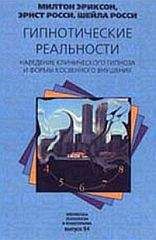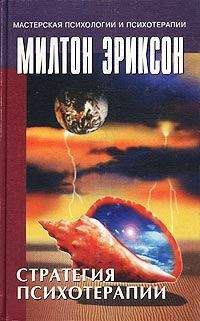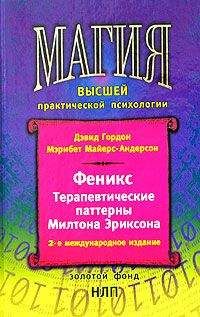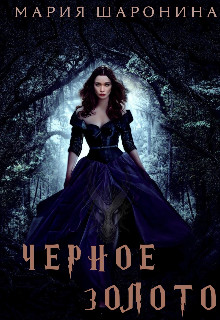Милтон Эриксон - Гипнотические реальности

Помощь проекту
Гипнотические реальности читать книгу онлайн
Erickson, M. Naturalistic techniques of hypnosis. American Journal of Clinical Hypnosis, 1958, I, 3–8.
Erickson, M. Further techniques of hypnosis-utilization techniques. American Journal of Clinical Hypnosis, 1959, 2, 3—21.
Erickson, M. Historical note on the hand levitation and other ideomotor techniques. American Journal of Clinical Hypnosis, 1961, 3, 196–199.
Erickson, M. Pantomime techniques in hypnosis and the implications. American Journal of Clinical Hypnosis, 1964, 7, 65–70. (a)
Erickson, M. Initial experiments investigating the nature of hypnosis. American Journal of Clinical Hypnosis, 1964, 7, 152–162. (b)
Erickson, M. A hypnotic technique for resistant patients. American Journal of Clinical Hypnosis, 1964, 1, 8—32. (c)
Erickson, M. A special enquiry with Aldous Huxley into the nature and character of vartious states of consciousness. American Journal of Clinical Hypnosis, 1965, 8, 14–33. (a)
Erickson, M. The use of symptoms as an integral part of therapy. American Journal of Clinical Hypnosis, 1965, 8, 57–65. (b)
Erickson, M. Experiential knowledge of hypnotic phenomena employed for hypnotherapy. American Journal of Clinical Hypnosis, 1966, 8, 299–309. (a)
Erickson, M. The interspersal hypnotic technique for symptom correction and pain control. American Journal of Clinical Hypnosis, 1966, 8, 198–209. (b)
Erickson, M. Further experimental investigation of hypnosis: Hypnotic and non-hypnotic realities. American Journal of Clinical Hypnosis, 1967, 10, 87—135.
Erickson, M. A field investigation by hypnosis of sound loci importance in human behaviour. American Journal of Clinical Hypnosis, 1973, 16, 92—109.
Erickson, M., and Erickson, E. Concerning the character of posthypnotic behaviour. Journal of General Psychology, 1941, 2, 94—133.
Erickson, M. and M., and Rossi, E. Varieties of Hypnotic Amnesia. American Journal of Clinical Hypnosis, 1974, 16, 225–239.
Erickson, M., and Rossi, E. Varieties of Double Bind. American Journal of Clinical Hypnosis, 1975, 17, 143–157.
Erickson, M., and Rossi, E. Two level communication and the microdynamics of trance. American Journal of Clinical Hypnosis, 1976, 18, 153–171.
Fischer, R. A cartography of ecstatic and meditative states. Science, 1971, 174, 897–904.
Fromm, Eric, and Shor, R. Hypnosis: research developments and perspectives. New
York: Aldine, 1972.
Gazzaniga, M. The split brain in man. Scientific American, 1967, 217, 24–29. Ghiselin, B. (Ed.) The creative process: A symposium. Berkeley: Mentor, 1952. Gill, M., and Brenman, M. Hypnosis and related states. New York: International Universities Press, 1959.
Haley, J. Strategies of psychotherapy. New York: Grune and Stratton, 1963. Haley, J. Uncommon therapy. New York: Norton, 1973.
Henle, M. On the relation between logic and thinking. Psychological review, 1962, 69, 366–398.
Hilgard, E. Hypnotic susceptibility. New York: Harcourt, 1965. Hilgard, J. Personality and hypnosis. Chicago: University of Chicago Press, 1970. Hilgard, E., and Hilgard, J. Hypnosis in the relief of pain. Los Altos, California: Kaufmann, 1975.
Hull, C. Hypnosis and suggestibility: An experimental approach. New York: AppletonCentury, 1933.
Jung, C. The structure and dynamics of the psyche. New York: Pantheon, 1960. Jung, C. Misterium conjunctionis. Princeton: Princeton University Press, 1963. Kinsbourne, M., and Smith, W. (Eds.) Hemispheric disconnection and cerebral function. Spriengfield, Ill.: C.C.Thomas, 1974.
Kroger, W. Clinical and experimental hypnosis. Philadelphia: Lippincott, 1963. Le Cron, L. A hypnotic technique for uncovering unconscious material. Journal of Clinical and Experimental Hypnosis, 1954, 2, 76–79.
Luria, A. The working brain. New York: Basic Books, 1973. Masters, W., and Johnson, V. Human sexual inadequacy. Boston: Little, Brown, 1970.
Meares, A.A. A working hypothesis as to the nature of hypnosis. American Medical Association Archives of Neurology and Psychiatry, 1957, 77, 549–555.
Morgan, A.H., MacDonald, H. and Hilgard, E.R. EEG Alpha: Lateral symmetry related to task and hypnotisability. Psychophisiology, 1974, 11, 275–286.
Morris, C. Foundations of the theory of signs. In O.Neurath, R.Carnap, and C.Morris (Eds.), I, International Encyclopaedia of Unified Science, Vols.1, 2, Chicago: University of Chicago Press, 1938.
Orne, M. The nature of hypnosis: artifact and essence.The Journal of abnormal and Social Psychology, 1959, 58, 277–299.
Pearson, R. Communication and Motivation. Part I. A fable. Part II. The brick — A personal experience. American Journal of Clinical Hypnosis, 1966, 9, 18–23. Perles, F. Gestalt therapy verbatim. LaFayette, Calif.: Real People Press, 1969. Ravitz, L. Application of the electro dynamic field theory in biology, psychiatry, medicine and hypnosis. I. General Survey. American Journal of Clinical Hypnosis, 1959, I, 135—150
Ravitz, L. History, measurement, and applicability of periodic changes in the electromagnetic field in health and disease. American Archives of New York Science, 1962, 98, 1144–1201.
Rossi, E. The breakout heuristic: A phenomenology of growth therapy with college students. Journal of Humanistic Psychology, 1968, 8, 6—28.
Rossi, E. Dreams and the growth of personality: Expanding awareness in psychotherapy. New York: Pergamon, 1972. (a)
Rossi, E. Selfreflexion in dreams. Psychotherapy, 1972, 9, 290–298. (b) Rossi, E. A dreamprotein hypothesis. American Journal of Psychiatry, 1973, 130, 1094–1097. (a)
Rossi, E. Psychological shocks and creative moments in psychotherapy. American Journal of Clinical Hypnosis, 1973, 16, 9—22. (b)
Rossi, E.The cerebral hemispheres in analytical psychology. Journal of Analytical Psychology, 1976, In Press.
Sacerdote, P. An analysis of induction procedures in hypnosis. American Journal of Clinical Hypnosis, 1970, 12, 236–253.
Sarbin, T., and Coe, W. Hypnosis: A socialpsychological analysis of influence communication. New York: Holt, 1972.
Scheflen, A. How behaviour means. New York: Aronson, 1974.
Sheehan, P. Hypnosis and manifestations of «imagination». In E.Promm and R.Shor (Eds.) Hypnosis: Research Developments and Perspectives. Chicago: Aldine-Atherton, 1972.
Shevrin, H. Does the average evoked response encode subliminal perception? Yes. A reply to Swartz and Rem. Psychophysiology, 1975, 12, 395–398.
Shor, R. Hypnosis and the concept of the generalised reality-orientation. American Journal of Psychotherapy, 1959, 13, 582–602.
Sperry, R. Hemisphere disconnection and unity in conscious awareness. American Psychologist, 1968, 23, 723–733.
Spiegel, H. An eye-roll test for hypnotisability. American Journal of Clinical Hypnosis, 1972, 15, 25–28.
Sternberg, S. Memory scanning: New findings and current controversies. Quartely-Journal of Experimental Psychology, 1975, 22, 1—32.
Switras, J. A comparison of the Eye-Roll test for hypnotisability and the Stanford Hypnotic Susceptibility Scale: Form A. American Journal of Clinical Hypnosis, 1974, 17, 54–55.
Tinterow, M.M. Foundations of hypnosis. Spriengfield, Ill.: C.C.Thomas, 1970. Watzlawick, P., Beavin, A., and Jackson, D. Pragmatics of human communication.
New York: Norton, 1967.
Watzlawick, P., Weakland, J., and Fisch, R. Change. New York: Norton, 1974. Weitzenhoffer, A. Hypnotism: An objective study in suggestibility. New York: Wiley, 1953.
Weitzenhoffer, A. General techniques of hypnotism. New York: Grune and Stratton, 1957.
Weitzenhoffer, A. Unconscious or co-conscious? Reflections upon certain recent trends in medical hypnosis. American Journal of Clinical Hypnosis, 1960, 2, 177–196.
Weitzenhoffer, A. The nature of hypnosis. Parts I and II. American Journal of Clinical Hypnosis, 1963, 5, 295–321; 6, 40–72.
Weitzenhoffer, A. Occular changes associated with passive hypnotic behaviour. American Journal of Clinical Hypnosis, 1971, 14, 102–121.
Weitzenhoffer, A., and Sjoberg, B. Suggestibility with or without hypnosis. Journal of Nervous and Mental Diseases, 1961 , 132, 204–220.
Weitzenhoffer, A. When is an «instruction» an «instruction»? International Journal of Clinical and Experimental Hypnosis, 1974, 22, 258–269.
Weitzenhoffer, A. Personal communication, 1975.
Wetterstrand, O. Hypnotism and its application to practical medicine. New York: Putnam, 1902.
Wheeler, L., Reis, H., Wolff, E., Grupsmith, E. and Mordkoff, A. Eye-roll and hypnotic sucseptibility. International Journal of Clinical and Experimental Hypnosis, 1974, 22, 329–334.
Whitehead, A., and Russell, B. Principia mathematica. Cambridge: Cambridge University Press, 1910.
Примечания
1
Импликация — подразумевание. В литературе по НЛП фигурирует как пресуппозиция. — Прим. ред.
2
Далее — «сигналинг». — Прим. ред
3
Ouija board, от французского и немецкого «да» (oui и ja) — приспособление для получения посланий из потустороннего мира на оккультных сеансах конца XIX века. Состоит из продолговатой доски с буквами алфавита, написанными полукругом по длинной стороне, и второй небольшой доски сердечком, подвижно закрепленной сверху. Участники сеанса кладут палец на верхнюю доску, ее острие движется и указывает на буквы. Если выпавшие буквы складываются в слова, предполагается, что это весточка от развоплощенных душ. — Прим. переводчика
4
Метафора, означающая свободный полет фантазии. — Прим. ред
5
Свершившийся факт (франц.)
6
В оригинале Sunflower, Weldon's Ditches, Suntower, Weldon's Britches, ассоциативный ряд выстраивается как flowers, Dutchman's Britches, Devil's Tower.

























